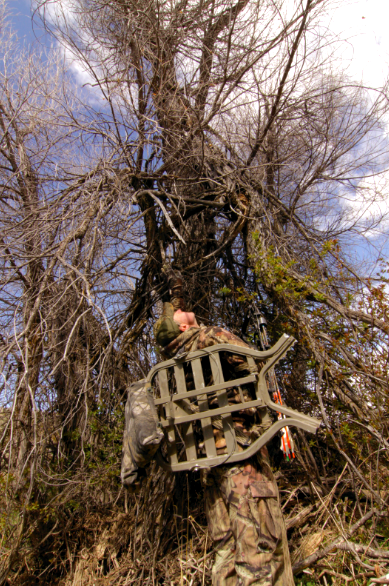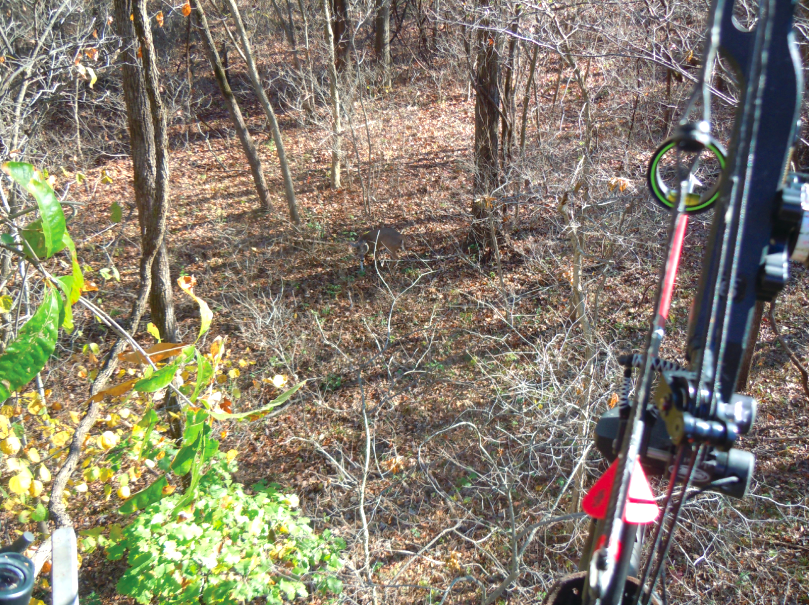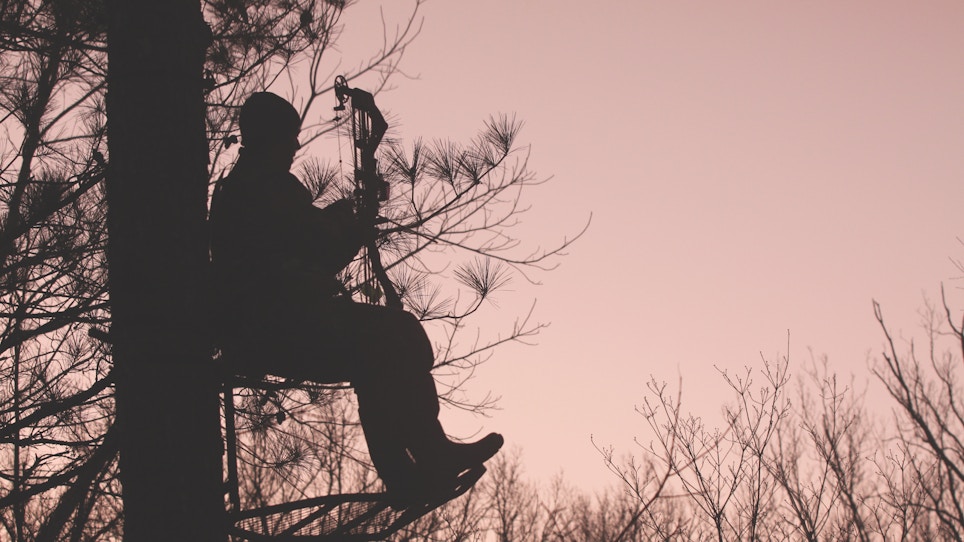"There’s no way that buck is eyeing me in this tree," I thought.
But the big 5x5 buck was staring a black hole straight through me. He skidded to a halt in the oak leaves below. What had caught his attention? Were whitetails learning to look up as well as forward? With me hidden 20 feet above in a treestand, and with my scent blowing squarely away from the buck, my answer was, “yes.”
When the above-ground advantage slips away as bucks adapt to hunting pressure, more concealment is required.
Choose a Trail Before Selecting the Tree
You can’t go looking for the right tree until you find the perfect route. And sometimes you have to adapt to what’s available. Even a small food plot requires precision planning to ambush a buck. Say a giant oak sits on the far side of the plot, but a mature buck always arrives from the opposite corner of the field. It does little good to put the stand in the oak if it’s out of bow range for the buck’s arrival.

Older trees are generally sturdier, plus they have a maze of branches to help conceal your stand. Photo: Mark Kayser
Matt Brunet is the whitetail and turkey hunting manager at Harpole’s Heartland Lodge in western Illinois. He’s been chasing whitetails for 26 years and has guided for a dozen years in game-rich Pike and Calhoun counties. Organizing meetings between whitetails and clients is Brunet’s job, and keeping those clients hidden in treestands ranks as a No. 1 priority.
Brunet relies on year-round scouting that combines both trail cameras and observing whitetails as they travel to food plots. This combination supplies him with the information he'll need to hang treestands along field edges and other rich deer habitat.
“Whether you’re hunting with an outfitter like Heartland or doing it yourself, the number one reason for success is from scouting. If you don’t put that as a top priority the traffic past any stand will suffer,” says Brunet.
Identifying the Best Ambush Site
Once you zero in on a target buck and his route, it’s time to find the best ambush site. Even though the buck might be as regular as your granddad on a high-fiber supplement, you have to consider every aspect of your hunt. Begin with the whitetail schedule at your site. Are the deer using the route in the mornings or evenings? This simple question forces you to look at how you enter and access a stand, particularly on a field edge and — even more importantly — if you’re trying to waylay a timber buck.
“Most of the time it is easier to hide a stand on an edge situation with confidence because the deer are more directional for the setup. You know where they are coming and you can place the stand to avoid detection,” says Brunet. “On interior locations, there’s more of a chance for deer to come from every direction. That can make it tough to have it hidden from all directions. That’s when you have to be extra careful in concealing your treestand.”
If a trail looks hot, it’s time to sneak in and narrow your choices for stand placement. Funnels and pinch points often crop up in whitetail conversation. Steep canyon walls, fencing, narrow necks of timber and other features prod whitetails into locations they rarely stray from, and that means a higher probability they’ll pass by your stand.
“Once I find a reliable travel route I don’t like to be any closer than 20 yards to a main trail for stand placement,” says Brunet. “Ideally, anything between 20 and 35 yards should be in the wheel house for most archery hunters. And if that isn’t happening, I will always take the better tree 10 yards further away as long as it’s still within my shooting range.”
Next, Brunet begins looking for the right tree. As he scans, he’s paying even more attention to the backdrop behind the area. He’s looking to avoid any natural features that might draw attention to a hunter. You'll want to consider these features from the ground level, mimicking the upward gaze of a stealthy buck.
“One of the most overlooked aspects of keeping a stand hidden is background cover; and you need to check that out from the ground, and the directions the deer are coming from," says Brunet. "You also need to check that out at the time of day you plan on hunting the stand the most. You don’t want to stand out or be a silhouette up in the tree. With little or no background cover, you may be fighting a losing battle.”
Identifying the Best Tree Within the Ambush Site
Now that you have a route and obscure location in mind, it’s time to pick a tree. This selection varies depending on your location. In the Midwest you could have several hardwoods to choose from. In the South or East, you could be staring at toothpick-straight pines.
Begin with this simple benchmark: think sturdy. And sturdy means mature for most tree species. An older tree doesn’t sway in the wind, it offers multiple trunks and branches for treestand placement and it leafs out fuller for added concealment.

Make sure your stand doesn't stand out. Look at it from a ground level to see if it is silhouetted. Photo: Mark Kayser
Brunet agrees and he believes an older tree takes your treestand invisibility to the next level.
“I don’t usually have a specific type or species of tree that I look for, but I do have certain qualifications that I try to find,” says Brunet. “I try to find a tree that’s about shoulder-diameter wide where I will be sitting, has good background cover when looking up at it from shooting lanes. and is simple and safe to access for climbing.”
Personal preference, shooting lanes, deer skittishness and other factors all come into play when considering whether your stand should point toward the trail; or if it's better to hide it behind the tree, facing the opposite direction. The very makeup of the tree, including limbs and how it angles, could be the deciding factor. Nevertheless, as Brunet points out, consider using the tree trunk for additional concealment.
For more tips to better treestand concealment, check-out the second installment of this two-part series. That article covers the recommended height for treestand placement, the consequences of fussing over foliage, plus a bonus tip about a hunter's foot traffic.






